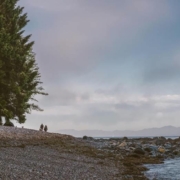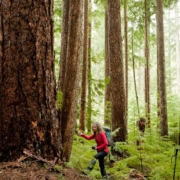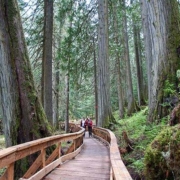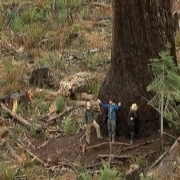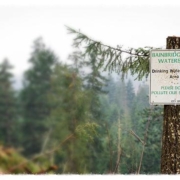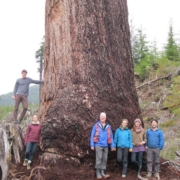There’s a certain romance in wondering what lies at the end of the road, and when the road in question is so intriguingly serpentine, sharply twisting and turning its way through the dense forest that runs parallel to the Juan de Fuca Strait off Vancouver Island, there’s a thrilling whiff of adventure in the air too. What lies at the end of the West Coast Highway – or Highway 14, to give it its rather more prosaic name – is Port Renfrew. Or, as I’ve taken to describing it: Tofino 20 years ago.
There’s that same arresting, wild West Coast scenery: wind-blasted Sitka spruce, pristine beaches, softly sloping hills bristling with Douglas fir and hemlock, and those awe-inspiringly huge waves breaking on the shore. But unlike Tofino – farther up the Vancouver Island coast – there are no surf shops or art galleries, no youth hostels or ritzy resort hotels, and very little in the way of, well, anything at all, really. Just endless natural beauty and – thanks to a recent renovation – a rather good pub, and surprisingly stylish seaside cottages.
But change is coming to the sleepy town, thanks to developer Ian Laing and family, who last year bought the pub, cabins and commercial land – essentially most of the town – from the former owner of Harlequin Enterprises (of romance-novel fame). They have big plans for the area, including a gift shop, gas station and commercial zone.
However, right now, with no cell signal, and just a two-hour drive from Victoria, it’s the perfect break for city types seeking a West Coast experience without the crowds. I’d gone looking for storms to watch and trails to hike and found them both in spades. However, I didn’t know that it was possible for rain to be this wet – sure, I was in a rain forest, but c’mon! I could feel it soaking through my usually impenetrable Canada Goose parka, a steady stream from my waterlogged tuque dripping down my face. No wonder it’s nicknamed Port Rainfrew.
After settling in at my cabin at Wild Renfrew, which featured a kitchen, bathtub and huge windows overlooking the ocean, I drove to the Botanical Beach Loop Trail, a part-boardwalk hike deep through the forest on a trail constructed by the youth of the Pacheedaht and T’Sou-ke First Nations.
In the heart of winter, plenty of leafy greenery was still on display; ferns glossy from the rain curled on each side of the trail, and mossy old man’s beard hung wispily from the soaring Douglas firs and chunky western red cedars. I was alone among the trees, and for a while, the only sound was the steady thrumming of torrential rain on the forest canopy and the squelch of my boots along the trail, until I started on a downhill section and heard the sea pounding the rocks below.
When I arrived on the beach, I shrieked with delight: Sitka spruce hunched low by the water determinedly growing in the gaps between the rocks – and oh, what rocks. Frilled like a mille-feuille pastry, ridges of shale and quartz jutted through black basalt and smooth sandstone, where centuries of relentless waves had worn deep tidal pools. I’d have loved this as a kid; this wasn’t a sandy beach where you’d build castles and lie snoozing in the sun. This was a beach to wear rain boots in all weathers, puddle-jumping and exploring the miniature world of the tidal-pool aquariums that trapped all kinds of fascinating marine life: urchins, starfish and chiton, until the tide rolled back in again.
Still, on a soaking day like this, I contented myself with picking over the rocks for an hour or so, before climbing the stairs back to the trail. Dried off and warmed up later, I tore into crisp, battered, juicy halibut and piled-high poutine with a decidedly fancy wine-kissed gravy at the Port Renfrew Pub. No ordinary middle-of-nowhere boozer, behind the bar there was an excellent selection of locally distilled spirits from the nearby Sheringham Distillery, and wine from small B.C. suppliers such as Unsworth Vineyards in Vancouver Island’s Cowichan Valley.
Sleepy after my feast, I curled up by the fire in my wooden cottage and watched entranced as plumes of rain-forest mist swirled up from the trees on the far-off hills, while the waves lashed the beach beyond my window. That night I was lulled to sleep by the sound of rain beating down on the roof, and I could hear the howl of the wind and the crash of the ocean outside.
The stormy deluge continued the next day and I ran through a sudden hailstorm to meet Drea Gibson for a guided hike through Avatar Grove to find “Canada’s Gnarliest Tree.” An ex-local, now living in nearby Shirley, “Day Trip Drea” runs guided hikes and camping trips around the area, and she proved a fun fount of knowledge.
There’s a fascinating back story to Avatar Grove, which only got its name a few years back after the Ancient Forest Alliance campaigned to have the area saved from logging and it was declared a protected area in 2012. Named after James Cameron’s epic 2009 movie, it’s home to some of the most ancient trees on Vancouver Island and just a few minutes drive from Port Renfrew. Unlike Cathedral Grove, a protected old-forest area on the way to Tofino, Avatar Grove is no simple stroll. Although the AFA has been laying down boardwalk to protect the root systems of the trees, there’s still plenty of clambering over logs and navigating slippery slopes before you reach the famous Gnarly Tree. You spend so much time looking where you’re going, in fact, that when you finally stop and look up, it’s more than a little overwhelming. Thoughts crash through your mind in rapid succession: Oh wow, that’s so beautiful. Oh man, that’s so big! And, most importantly: How the hell did anyone even think about logging this treasure?
As Gibson and I stop to take in the jaw-clanging abundance of arboreal beauty, we talk about the attractions of the area: “The really big draw is that there is nothing to do,” she says with a grin. “It’s wild and it’s rugged; you can hike, swim, fish and just have your own spot here.” Throughout the summer, Gibson says, the little town transforms again as the handful of other businesses open for the season, and the cabins and campgrounds are full of visiting families. “It still feels pristine and untouched,” Gibson adds. “I love Port Renfrew because it’s quiet and quaint and gorgeous.”
As we clamber back down to the road again, the rain finally dries up and I’m rewarded with an extraordinary, vivid rainbow emblazoned across the sky.
Later that day I explore the sandy beach at the Pacheedaht Campground; again I’m the only person there to watch bald eagles wheel overhead as I perch on an orange arbutus log. As magic hour swings around, the light turns the gun-metal grey sea into a golden-apricot swath of silk shimmering between the mountains and the shoreline. I sigh with contentment and happiness – and rainbows – found at the end of the road.
Read more: https://www.theglobeandmail.com/life/travel/destinations/overwhelming-beauty-almost-every-inch-of-port-renfrew-bc-inspiresawe/article29583454/


